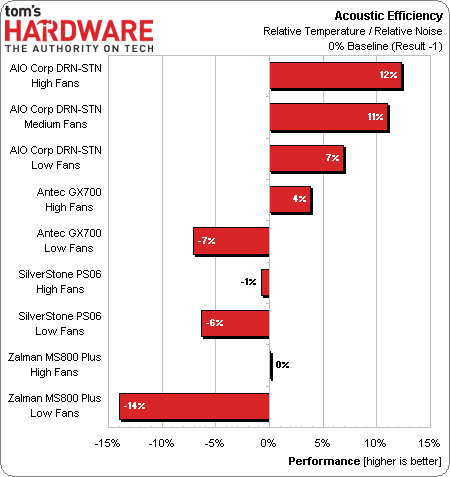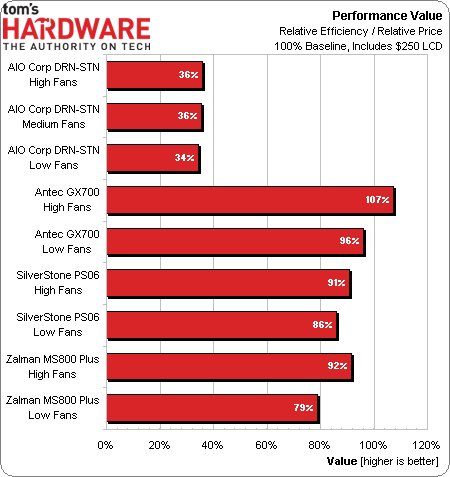AIO DRN-STN Review: A Gaming All-In-One With A 120 Hz Display
The AIO Drone Station is a combination chassis and 120 Hz FHD display, ready to take your choice of ATX motherboard, CPU, graphics cards, storage, and power supply. We'd stop short of calling it portable, but appreciate the appeal of a fast all-in-one PC.
DRN-STN: The AIO Gaming Paradigm?
Any company could win a cooling test by adding a bunch of noisy high-flow fans, and most companies could win a noise test by using a few low-speed fans to vent the chassis. The true measure of performance is thus the comparison of cooling-to-noise.
AIO Corporation’s Drone Station appears to be the paradigm of cooling-to-noise performance. But what about its screen? A top TN panel, it’s still limited to six-bit color and uses dithering to approximate an eight-bit depth. TN panels are fast, making them a good solution for gamers, despite the derision thrown at them by photo professionals. The 144 Hz version of this 120 Hz panel even earned value honors in last fall’s test at a price of $270.
In the DRN-STN we find paradigm cooling performance and paradigm-approximate display performance in a single package. So, what’s the catch? Well, we could begin with the 38+-pound weight, which means a 50+-pound filled system for most gamers. And at 25.9” wide, your arms need to be as long as they are strong. Carrying this thing through doorways can also be difficult, though there wasn't much the designers could do to avoid that issue, pairing a 24” display and a full ATX case.
Most three-way SLI-capable motherboards require an eighth slot that the DRN-STN doesn’t have to make room for a third card. But there are a few exceptions that can still make this case work with that feature. Then again, one FHD display doesn't justify the graphics horsepower of three cards. Use two well-balanced GPUs and you'll be fine.
Less-obvious flaws include the flimsy internal chassis with knock-out slot covers and a too-small EPS12V access hole, and foam panel cover that feels only moderately sturdy. We’d like to use that cover as long as possible for protecting the display, but can’t guarantee its longevity. More bothersome was that, after the two halves of the outer shell settled in during shipping, the latches no longer had enough travel to lock the thing together.
Supposing that AIO Corporation is able to condition the panels to prevent the latches from losing their usefulness with age, we think the firm still has a fairly solid product. And that analysis is focused mostly on the quality of its outer shell and its overall performance. At least the low-end internal structure is well protected!
In working up the value story for AIO's Drone Station, we noticed that monitors employing this platform's display panel are going for around $250. What's more, they offer refresh rates of up to 144 Hz (compared to the DRN-STN's 120 Hz screen). That fact alone wouldn't have been an issue if the case component were more affordable. But a $250 display and a $750 chassis is a rough combination to swallow. It'd need to be carbon fiber and aluminum, rather than plastic and super-thin steel, to warrant such a premium. Perfection would have been mandatory to justify a $1000 price tag using these components. That's not what we have, though.
Get Tom's Hardware's best news and in-depth reviews, straight to your inbox.
We like the DRN-STN a lot, but it lacks the polish our U.S. demands to garner our highest award. Next, we turned our attention to value, but found a price tag more than double what we'd be looking to pay. Otherwise-excellent performance and the convenience of an all-in-one certainly win the DRN-STN a place in our hearts. However, our wallets are the voice of reason.
Current page: DRN-STN: The AIO Gaming Paradigm?
Prev Page Thermal And Acoustic Test Results-
blackmagnum What does this retro looking gaming box have over an established gaming notebook say an Alienware or Asus? Thanks for the choice though.Reply -
Crashman Reply
Up to 20x the graphics power and 2x the CPU performance? I guess it depends on what you plan to do with all that extra space.12698017 said:What does this retro looking gaming box have over an established gaming notebook say an Alienware or Asus? Thanks for the choice though.
I also didn't get a chance to note in the article that "Full Sized" power supply means PS/2 form factor (and extended versions thereof). ATX power standard does not include a form factor, because form factors designate "form". This is, in spite of what Yahoo Answers might tell you. So "Full ATX" is a misnomer concerning power supplies.
-
bloody llama The internal case appears to be made by NZXT. The 3.5" rails and the PCI toolless latch are exactly the same as my NZXT case from 2005.Reply -
Crashman Reply
NZXT doesn't manufacture its own cases though, or at least it didn't in 2005 :)12698206 said:The internal case appears to be made by NZXT. The 3.5" rails and the PCI toolless latch are exactly the same as my NZXT case from 2005.
-
Nossy wow,..$700 for a case, and people are complaining about a $700 video card? WTF are people smoking these days?Reply -
Au_equus Is it oversimplification to say that the system looks like a monitor and a case held together by a shroud? I agree with Trutherizer, especially at that price, but, to go a little bit further, it needs a docking station for a keyboard and mouse.Reply


